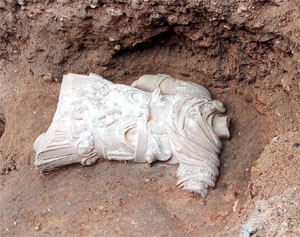The Caesareum site (Former Garage Lux)
On 31 August 2002, we closed the salvage excavation of the former
Garage Lux and Park Cinema and handed the plot back to its owners. The following
day, bulldozers took over the site.
No less than eight archaeologists followed one another or else
worked together over a period of two year's of digging. The working conditions
were particularly trying with periods of high tension when the developers used
their mechanical diggers to eat into the land left for the archaeologists.
 For
all that, the information we obtained was rich and varied. We noted the presence
of half a dozen cisterns from the medieval period lined up, one after the other,
then a Christian cemetery of the 6th century AD probably connected to the Caesareum,
the Imperial temple having been transformed into a church by the followers of
Arian in 345 and inaugurated by Athanasius in 356. This cemetery was situated
intra muros, which is interest in our expanding knowledge of the topography
of the city at the Byzantine period. Under the cemetery we uncovered vestiges
belonging to a pagan temple, perhaps most notably a colossal statue in white
marble of a Roman emperor wearing a breastplate. It can be dated to the end
of the 2nd century AD and from the remains of the beard we might recognise Marcus
Aurelius or Septimius Severus. It would have been one of the portraits of the
sovereigns that were held in the temple, as we know from Philo's description
of the Caesareum. There were also the remains of Aswan granite columns of astonishing
diameter, and a chamber held up by pillars with a coffered ceiling decorated
with stucco, parts of which still bore brightly coloured nelumbos motifs.
For
all that, the information we obtained was rich and varied. We noted the presence
of half a dozen cisterns from the medieval period lined up, one after the other,
then a Christian cemetery of the 6th century AD probably connected to the Caesareum,
the Imperial temple having been transformed into a church by the followers of
Arian in 345 and inaugurated by Athanasius in 356. This cemetery was situated
intra muros, which is interest in our expanding knowledge of the topography
of the city at the Byzantine period. Under the cemetery we uncovered vestiges
belonging to a pagan temple, perhaps most notably a colossal statue in white
marble of a Roman emperor wearing a breastplate. It can be dated to the end
of the 2nd century AD and from the remains of the beard we might recognise Marcus
Aurelius or Septimius Severus. It would have been one of the portraits of the
sovereigns that were held in the temple, as we know from Philo's description
of the Caesareum. There were also the remains of Aswan granite columns of astonishing
diameter, and a chamber held up by pillars with a coffered ceiling decorated
with stucco, parts of which still bore brightly coloured nelumbos motifs.
The excavation now being over, the study has begun and seems
to lend itself to a publication dedicated to the Caesareum. We are waiting for
the imminent destruction of the last buildings on the site, what was known as
the French market or sometimes "souq el missala", that is, the Obelisk Market.
Cleopatra's Needles once stood not far from here.
 For
all that, the information we obtained was rich and varied. We noted the presence
of half a dozen cisterns from the medieval period lined up, one after the other,
then a Christian cemetery of the 6th century AD probably connected to the Caesareum,
the Imperial temple having been transformed into a church by the followers of
Arian in 345 and inaugurated by Athanasius in 356. This cemetery was situated
intra muros, which is interest in our expanding knowledge of the topography
of the city at the Byzantine period. Under the cemetery we uncovered vestiges
belonging to a pagan temple, perhaps most notably a colossal statue in white
marble of a Roman emperor wearing a breastplate. It can be dated to the end
of the 2nd century AD and from the remains of the beard we might recognise Marcus
Aurelius or Septimius Severus. It would have been one of the portraits of the
sovereigns that were held in the temple, as we know from Philo's description
of the Caesareum. There were also the remains of Aswan granite columns of astonishing
diameter, and a chamber held up by pillars with a coffered ceiling decorated
with stucco, parts of which still bore brightly coloured nelumbos motifs.
For
all that, the information we obtained was rich and varied. We noted the presence
of half a dozen cisterns from the medieval period lined up, one after the other,
then a Christian cemetery of the 6th century AD probably connected to the Caesareum,
the Imperial temple having been transformed into a church by the followers of
Arian in 345 and inaugurated by Athanasius in 356. This cemetery was situated
intra muros, which is interest in our expanding knowledge of the topography
of the city at the Byzantine period. Under the cemetery we uncovered vestiges
belonging to a pagan temple, perhaps most notably a colossal statue in white
marble of a Roman emperor wearing a breastplate. It can be dated to the end
of the 2nd century AD and from the remains of the beard we might recognise Marcus
Aurelius or Septimius Severus. It would have been one of the portraits of the
sovereigns that were held in the temple, as we know from Philo's description
of the Caesareum. There were also the remains of Aswan granite columns of astonishing
diameter, and a chamber held up by pillars with a coffered ceiling decorated
with stucco, parts of which still bore brightly coloured nelumbos motifs.